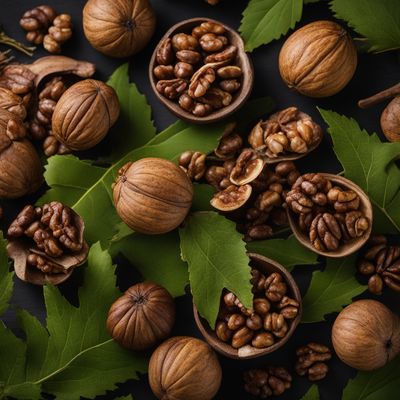
Ingredient
Walnut infusion leaves
The Essence of Walnut Infusion Leaves
Walnut infusion leaves are dark green, glossy leaves that possess a strong aroma reminiscent of walnuts. They have a slightly bitter taste and a delicate texture, making them a versatile ingredient in both sweet and savory dishes. These leaves are often used to infuse oils, vinegars, and spirits, adding a nutty depth of flavor to various recipes.
Origins and history
Walnut infusion leaves have been used in traditional medicine and culinary practices for centuries. Native to the Mediterranean region, they have a rich history dating back to ancient times. These leaves were highly valued for their medicinal properties and were believed to have various health benefits. Today, they are widely used in Mediterranean and Middle Eastern cuisines, adding a distinct nutty flavor to dishes.
Nutritional information
Walnut infusion leaves are a good source of antioxidants, healthy fats, and essential minerals. They are also low in calories, making them a nutritious addition to meals.
Allergens
There are no known allergens associated with walnut infusion leaves.
How to select
When selecting walnut infusion leaves, look for fresh, vibrant green leaves that are free from blemishes or discoloration. Avoid leaves that appear wilted or have a strong, unpleasant odor. Opt for organically grown leaves whenever possible to ensure the absence of pesticides or chemicals.
Storage recommendations
To maintain the freshness and quality of walnut infusion leaves, store them in a sealed plastic bag or airtight container in the refrigerator. They can stay fresh for up to a week when stored properly. Avoid washing the leaves until ready to use, as excess moisture can cause them to wilt.
How to produce
Walnut infusion leaves can be grown in a home garden or in pots. They require well-drained soil and partial shade to thrive. Regular watering and pruning are necessary to maintain healthy growth. It is recommended to consult a gardening guide or expert for specific cultivation instructions.
Preparation tips
Walnut infusion leaves can be used to infuse oils, vinegars, and spirits, adding a distinct nutty flavor to dressings, marinades, and cocktails. They can also be used as a garnish for salads, soups, or roasted vegetables. Additionally, these leaves can be steeped in hot water to create a fragrant tea or used as a flavoring agent in baked goods and desserts.
Culinary uses
Walnut infusion leaves are commonly used in Mediterranean and Middle Eastern cuisines. They are often found in dishes such as walnut-infused olive oil, walnut leaf tea, and walnut-flavored desserts. These leaves are popular in regions where walnuts are abundant, such as Greece, Turkey, and Iran.
Availability
Walnut infusion leaves are commonly available in regions where walnuts are grown, such as the Mediterranean countries, the Middle East, and parts of Asia. They can also be found in specialty stores or online retailers that offer culinary herbs and ingredients.

